I’m 14, my belly pressed into the carpet, head in hands, watching the little green Facebook Messenger dot flicker on and off. The Great Gatsby green beacon of the ‘online’ status. He’s there.
Today at lunchtime, Eric George looked at me outside the library. He turned and said something to his friend, which I imagine was along the lines of ‘there’s Harriet look how fit she is, I can’t wait to go online and chat to her later’ but was probably more like ‘I’m getting COD Modern Warfare 2 on Friday’. That doesn’t matter now. All that matters is me, my mum not hearing that I’m awake, and the little green dot.
For the last 4 months, green dot and I have been Facebook official girlfriend and boyfriend. A relationship built on walking each other home from school (ok— me walking him home from school and then walking myself home from his), avoiding each other in school (ok— him avoiding me and me pretending not to notice) and the occasional late night poke. This was the first of fourteen relationships I’d go on to have with predominantly dismissive avoidant men, and up until a few weeks ago, it was the one that hurt the most.
Ten years later—on June 4th, 2019—at 24 years old, I attended my first 12-step meeting. As with most fight club-esque gatherings, mentioning a specific 12-step is seen as promotion, and therefore discouraged by the groups. And although I’m no longer ‘in it’, I shouldn’t really expose the group for karmic reasons. All I’ll say is, it’s the Scousest-sounding one of them all (“Siri, what is SLAA?”).
Sitting in an underfunded church hall in Brixton on piss-coloured melamine chairs, huddled in a tight circle, I couldn’t believe how much this 12-step looked like the ones in the films. As a devout fantasist, I have a tendency to romanticise the less-glam parts of my life by imagining they’re just the scenes that didn’t quite make it into Richard Ayoade’s ‘Submarine’. But even as an expert in this practice of compartmentalisation, it was hard to shift the shame and desperation that bubbled up when I realised that this was where I’d ended up.
I’d started crying before I’d even said my name. Hearing the experienced ‘steppers’ speaking with such familiarity and ease about things I’d never even considered admitting in quiet, never mind out loud, made me feel simultaneously less alone and completely terrified. It was in this moment that I realised my plan to just grow out of my ‘person addiction’ was as flawed as I’d feared. Addiction isn’t something you grow out of. It’s something you have to watch, and manage, and soothe, like a sick animal that’s been left in your care. Impossible to live with and even more impossible to kill.
I only lasted a few months, because that’s about as long as you can put off the first step before people start to think you’re a method actor soaking up the suffering of addicts to land a forgettable role. Part of the first step —admission— demanded I break up with my then-boyfriend, Darren. He didn’t know I was attending a 12-step program, and I was entirely devoted to him in every shape and form, so this was a strong no from me. I still, to this day, struggle to understand how the first sensible step to giving up addiction is to ‘just give it up’. As if I hadn’t thought of that. Something I think this speaks to is that sex addiction and love addiction are very different beasts: Sex is an act you can eliminate from your day to day, but being connected to and involved with people is not. In my opinion, banding these two things together is a crucial oversight of this particular group.
My failure to complete Step One in this group-therapy setting led me to seek out a more private solution. When I walked into Tooting’s emergency psychotherapy reception area, my hopes were low, but I was desperate. I didn’t know it then, but I was about to meet the therapist who would simultaneously save, and ruin, my life.
Before I get into therapy, I want to explain a little more about what being addicted to a person can look like. Person addiction, or limerence*, is so normalised in popular culture that spotting when a harmless crush develops into an all-consuming obsession is a skill reserved for the lifers, like me. Some of my smartest, most self-aware girlfriends fall victim to confusing obsession with love, and who can blame them when it's romanticised in every film, song, and social media post we consume. On TikTok or Instagram, you can barely move for a “10 innocent texts to make him obsessed with you” or “here’s why he’s not texting you back” or “want to see who’s looking at your profile? download this app!” or “me after checking his recent follow list”. What can feel like fate sending creepily specific, ‘this found me for a reason’ content your way is actually just the algorithm highlighting how much of an epidemic this type of obsessive, compulsive thinking is for certain demographics, and social media’s criminal role in exacerbating it. But social media as a catalyst for addiction is a whole other conversation for another day.
*Limerence: Noun, The state of being infatuated or obsessed with someone; different from love or lust. Coined by American psychologist Dr. Dorothy Tennov in her 1970s book Love and Limerence: The Experience of Being in Love.
It’s 7 PM on a Tuesday, and somewhere between the ages of 14 and 29, I’m drafting a text to a man in my notes app. At some unidentifiable point, writing and rewriting it becomes the activity rather than the process. Deciding between ‘Hey’ and ‘Heyyy’. Quitting it. Doing a lap of my living room. Reopening it. ‘Hey’ sounds more direct. I check WhatsApp — and shit — he’s online. I’m not doing it. It’s stupid. But actually, ‘Heyyy’ sounds more casual. I send the draft to whoever isn’t already sick of his name. I don’t wait for or care about their feedback. His little status morphs from ‘online’ to ‘typing…’, and my body reacts like it’s witnessing a pram rolling towards a platform edge. I stop breathing so I can focus on the flickering ellipsis. The thought, ‘to see him typing is all I’ve ever wanted’ interrupts my asphyxiation. And there it is: the truth. The ‘typing…’, the drafting and redrafting, the shaving everything sub-eyelash, the research for the perfect pore-hiding-dimly-lit-but-still-able-to-see-me London spot. The preparation—that’s where the fantasy lives. That’s where the addiction thrives. As soon as [insert name here] is sitting across from me in [generic London pub] at some [day and time], I’m already thinking about the next. The next text; the next date; the next [insert name here]. In other words, the artist is anything but present.
After the chase (the messaging), and the fix (the one-time meet up, meaningless fling, or sometimes full-blown 2 year relationship), comes withdrawal. Withdrawal feels like it will never end. All of my withdrawals, up until a few months ago, ended in something else starting. Applying some other person over the top of the other, not dissimilar to my landlords approach to re-decorating. Any addict will tell you that the best distraction from dependency is a new kind of dependency. After all, there’s a reason why so many different 12-step groups welcome the same cast of faces, and this is no different.
To a healthily-adjusted individual, it might seem somewhat normal to dedicate time to composing an important message. But this obsessive behaviour isn't confined to the act of texting; it seeps into every aspect of my life.
Every picture I have of myself from the last two decades tells a story of obsession. Each outfit was carefully chosen, each pose deliberately struck. My hair length, my clothes, even weight, determined by the preference of another —each detail a silent signal to the person currently occupying my thoughts. My memories aren't marked by milestones or celebrations, but by the fixes, and the spaces between them: the anticipation of a text, the thrill of a potential encounter, the crushing weight of waiting. Looking back, I can map my entire life through these obsessions. It’s like reminiscing through your medical records rather than a sentimental photo album.
I could go on about limerence forever — there are so many markers and symptoms, too many to list here. If any of this resonates with you, but you’re unsure you’re suffering from limerence, I’ve found that some pretty good telltale signs are the answers to the following questions: Does your need for them to like you feel more important than your feelings for them? Are you shaping your interactions to be a version of yourself they’ll like, instead of staying true to who you really are? And, the killer, does everything else in your life feel ‘less than’ now you know them? If any of your answers to the following are yes, me and you are going to be great friends.
When I first started seeing my therapist, Paul, I had no idea that his specialties included childhood trauma, sexual relationships, and attachment theory. Along with his extensive knowledge of the arts, film, and his uncanny ability to laugh only at my truly, truly funny jokes, combined with his expertise, made him the perfect person for me to work with. Like many who experience limerence, I struggle with recognising and setting boundaries, which is why Paul’s professionalism and unwavering commitment to his craft have created a space where I can explore vulnerability without fear. During our first session, I told him I’d budgeted for exactly 8 sessions of therapy—something he agreed to. Fast forward 5½ years and 286 sessions later, and I can confidently say that our work together is the best reason I can’t afford to buy a house.
It wasn’t just about sorting through the mess of my relationships; it was about confronting myself. There’s something unsettling about sitting across from someone who has no agenda, no judgments, no emotional pulls—just an intense focus on unraveling what makes you tick (in my case, that's yearning for avoidant, sexually frustrated men, who think ‘attachment style’ is a Kama Sutra position). Over the years, I began to realise my compulsions weren’t isolated incidents of ‘falling for the wrong person.’ They were reflections of a deeper need for validation, a yearning to fill parts of myself I couldn’t reach alone. The men I was drawn to—the emotionally distant, dismissive avoidants—were the perfect bait for someone like me, leaving just enough space for my imagination to run wild. Tortured artists, troubled writers, stand-up comedians, men with autism— were all, unintentionally, masters of curation and distance. They unknowingly crafted their identities meticulously, offering just enough to keep me hooked, but never enough to feel truly close. They mirrored my own need for distance, and I was captivated by their ability to hide the parts of themselves they couldn’t face, just as I had learned to hide mine.
At the risk of sounding like I’m blaming anyone other than both parties, I was concealing just as much. I knowingly crafted myself as the picture of female sexuality (just scroll through my old posts on @badrichardson, now rebranded as @WIPrichardson for hopefully obvious reasons, if you need proof), curating a version that made me desirable, but never truly seen. My need to be wanted wasn’t about the men I chose; it was about avoiding the parts of myself I felt were unworthy. I mirrored their emotional distance, creating just enough of a version of me to make them feel safe, but never enough to actually connect. I wasn’t seeking intimacy—I was seeking confirmation that I wasn’t alone in this particular flavour of struggle.
Therapy became the first place I truly began to understand the root of these behaviours—not just a quick fix, but a long, slow process of confronting the pain beneath the performance. It wasn’t (and isn’t) easy. It’s not linear, or without fuck-ups. It didn’t happen overnight. And sometimes I can even feel like it’s ruined my life, like not knowing would’ve been easier, maybe even kinder some days. But for the first time in my adult life, I’ve started to feel like I’m not just performing for someone else, but actually learning to ‘be’. Ironically, but by no coincidence, as the performance started to leave my romantic and sex life, it found a more comfortable spot elsewhere. Enter: performance art.
If you don’t think the picture I’ve just painted has all the same hallmarks as Tehching Hsieh’s Time Clock Piece, then you don’t understand performance art. If you don’t think counting 1000 calories each day for 6 months to get the guy at work to notice me, or drafting and re-drafting every single text I’ve ever sent to a man with a moustache, or dedicating an entire weekend to arranging my attic room to look just the right amount of lived-in while the occupant feels anything but alive—if you don’t see that as performance art, then you just don’t get it.
Having a photographic memory of the exact 2361 followers he had last night, but this morning it’s 2362 is titled ‘Withdrawal, 2020’. Wallowing in 8 orgasms in a day whilst refusing to get dressed out of the festering jogger bottoms and eating only what is within reach of the bed, is titled ‘Aftermath, 2021’. Unfollowing every single male comedian who’s ever slipped into my DM’s on a Tuesday afternoon in Leon is called ‘Breakthrough, 2025’.
To be in my head, tolerating my thoughts, 24 hours a day, and not ending it all— for 29 years, 8 months, 6 days, and 4 hours— that’s f*cking performance art.
In February of last year I embarked on 100 dates with 100 people over a non-stop 16 hour performance. When I’m asked about the mental stamina and alertness that those kind of interactions demand, I take pride in explaining that that’s nothing compared to the mental anguish that inspired the piece. The familiar but never less devastating performance of compulsion, infatuation, obsession and loss.
To be an artist is to dedicate ones life to compulsion. Being able to separate the compulsion that drives me to perform 100 Dates, or Temporary, or Scandalous, from that which delivers me to my crushes cousin’s dance troop’s Facebook page at 3am isn’t something that comes naturally. Carving out the aspects of obsession that serve me while discarding those that don’t is a painful, humiliating process—one I intend to dedicate my life to mastering.
I could talk about one specific man. I could talk about the 14 men I’ve slept with to date. I could talk about the eight of those that turned into a relationship. I could talk about the seven I broke up with, or the one that broke up with me. But the pain of repetition is what makes obsession, and limerence, so humiliatingly addictive.
Am I worried that any of the dismissive avoidants will read this? No. Not because I have a particular attraction to the illiterate (although, judging by the number of love letters I’ve received in my life, I’m starting to question this)—but because of the nature of that attachment style. In short, being attracted to avoidant men means there’s no chance in hell I’ll be humanised by them, in the same way they weren’t by me. Did the participants of Abramović’s ‘The Artist Is Present’ watch the piece from start to finish? Did they even know her work beforehand? Did they even care? I think all both parties really wanted was to be perceived.
I have devoted my life to this performance. From adolescence, I haven’t known life without the chokehold of devotion to a concept of a man (no, I didn’t steal that from Tr*mp). An unattainable other that keeps me from facing my idea of self.
When I can’t fall asleep at night, I get stuck on a scene that never happened and play it over and over again in my head. Sometimes it’s [insert name here] noticing me for the first time in a room full of people, sometimes it’s us kissing, other times it’s what our conversation would’ve been if we’d had a last one.
This one’s my favourite: It’s me, dragging myself by the hair out of his gig— the one where we first met. A sort of ‘It’s a Wonderful Life’ intervention where I get the chance to stop the crush in it’s tracks. It’s the moment between me biding my time with his tech guy and our first hello. Not the sexy mud-wrestling pop-up-ad woman-on-woman kind of hair pulling. The kind where I’m kicking and screaming and digging my heels into other-me’s shins, the veins bulging from my neck, spit leaking onto my chin and foaming at the corners of my mouth. The kind where there’s bits of splinter and paint gathering under my fingernails as I claw the venue’s doorframe in a raw, aching desperation to say a cool, calm ‘heyyy’. As ‘The Ghost of Future Me’ pushes into my chest with all her weight, she knows that present-me is stronger.
He looks over. And for a moment, me and her both quickly straighten up, and present me smiles at him. “Sorry about my friend” she says, shrugging my hand off her arm. “She’s… in a bad place”. Future me isn’t there when she turns around. Up until recently, there’s always only been one ending to this scene.
Devotion to an avoidant man is the anticipation of reward without the assurance that it exists— that you’ll ever achieve anything more than your own suffering. That’s performance art.
I've been writing this piece for a while, for about 6 months. In fact, when I started it, I was in a 4 year relationship with the first man I’ve ever really loved. The kind of love that makes you realise every other time you’ve used that word it may as well have been a nervous tick. As I'm penning this ending, I'm single. I can say with confidence that he was the first partner to know me fully. He eventually got to see all of the very ugly parts, along with the beautiful. And although that makes it somewhat more difficult to see him leave, it gives me the confidence that his decision to do so was rooted in complete truth.
And that's the difficult thing about love, the thing I didn’t know before: that it’s a decision, and therefore an action. He loved me for a long time, but the unforgiving claws of addiction, and the growing pains from drastically, sometimes clumsily, working through all of these issues from within our relationship, was too much for both of us. It was never that he stopped loving me—it’s that he had to stop loving me for the both of us. This is, of course, part of a much longer, much more complex, and more lovely story, but one that taught me more about love than I ever thought possible. At the risk of sounding like a B&M Bargins kitchen wall vinyl— sometimes the greatest act of love is knowing when to let go.
When he left, my biggest fear was relapsing. But I didn’t—and I haven’t. I haven’t because I finally understand the importance in sitting with the pain without trying to chase it away or paint over it with someone else. I’ve learned, awkwardly and painfully, that healing isn’t a performance—it’s an act of surrender.
To end all of this with a breakup would be a disservice to myself. There are many things I am— a recovering addict, a cheat, a fantasist. An artist, a yearner, a lover— but one of the things I’m proudest to be is dedicated. Dedicated to finding myself, to my art, to truth. To finishing what someone else, in some other traumatised generation, began. There have been countless moments in the past few weeks when watching my body decompose seemed inconceivably more appealing than dragging it into the sun. Times when denying myself food, movement, or connection would’ve been infinitely easier than embracing nourishment. But here I am— finishing this writing with the sun on my screen, making these words almost invisible.
So, what are my hopes now? As with most of my work, this piece serves a purpose—for both me and my life. The next time I’m offered a comp from a comedian everyone’s already slept with, or an ex-little-green-dot reaches out with a ‘u up?,’ or some journalist dad of two expects more than just an interview; When I’m asked why I’m skipping an event, why I’m ‘not as fun as I used to be’, or why I’ve unfollowed 40 men on Instagram, I’ll send this writing. I, like everyone else, deserve genuine interactions with people willing to truly get to know me— and nothing’s more ‘me’ that writing a selfie-illustrated Substack titled ‘Avoidant Men And Endurance Art’. I want to live authentically, without the need for masking or curation. I want to reserve my durational performance art for something more meaningful than just an avoidant audience of one.
Peace & love,
Harriet
--
This writing is dedicated to: my ex-boyfriends, to my love, to the addicts who are fighting, winning, and to those who have lost.





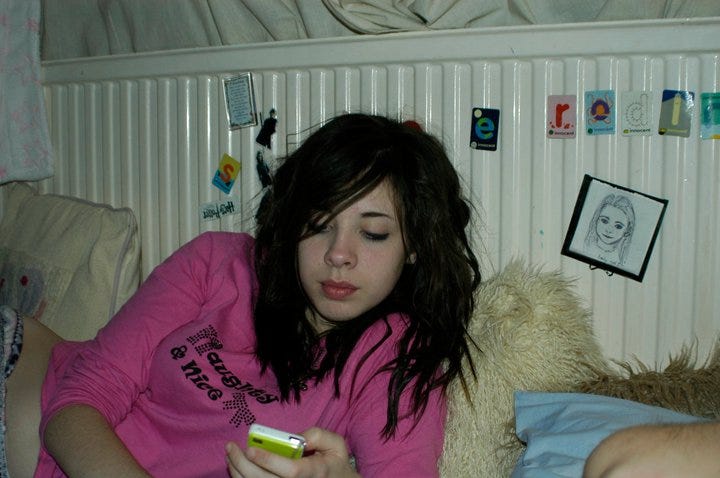
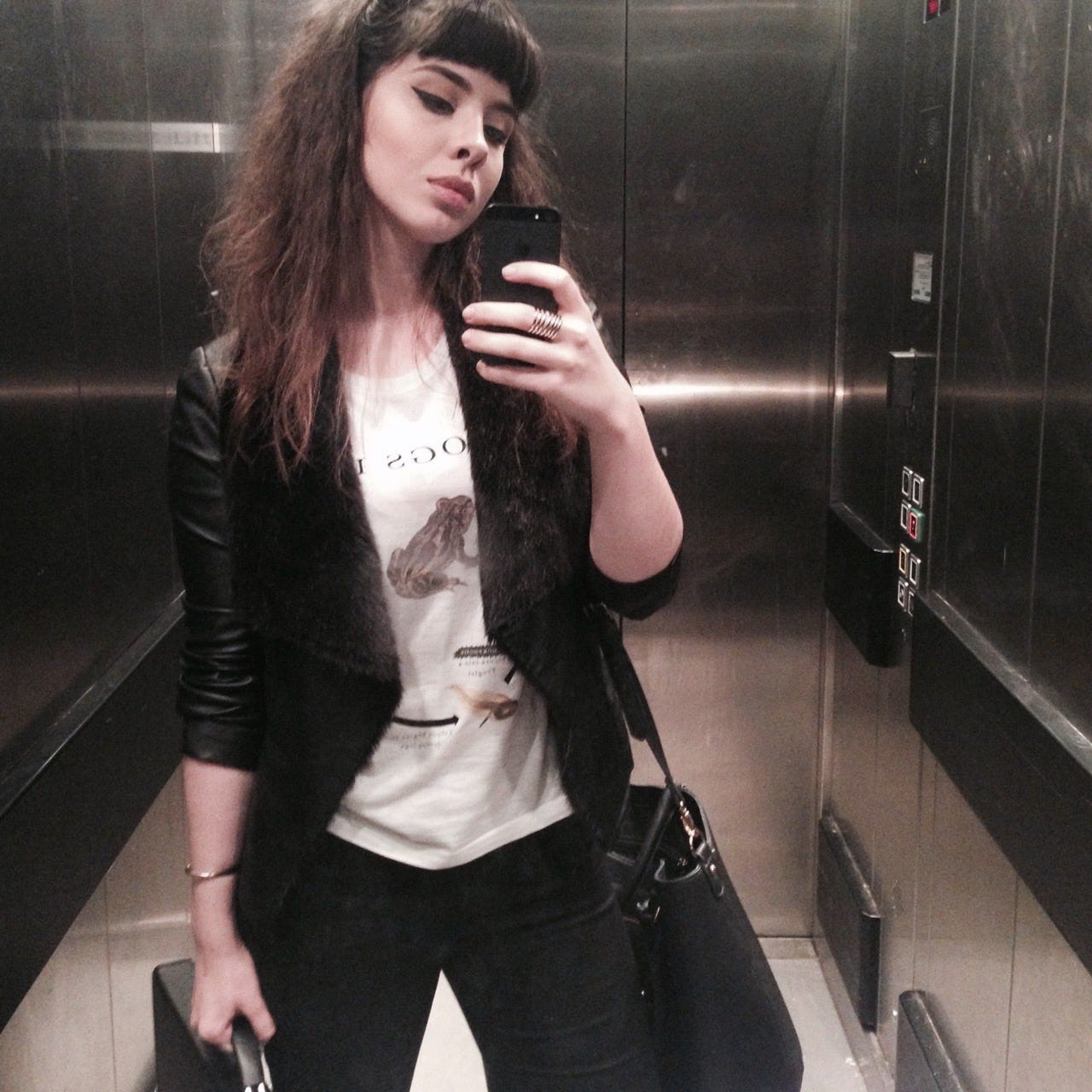
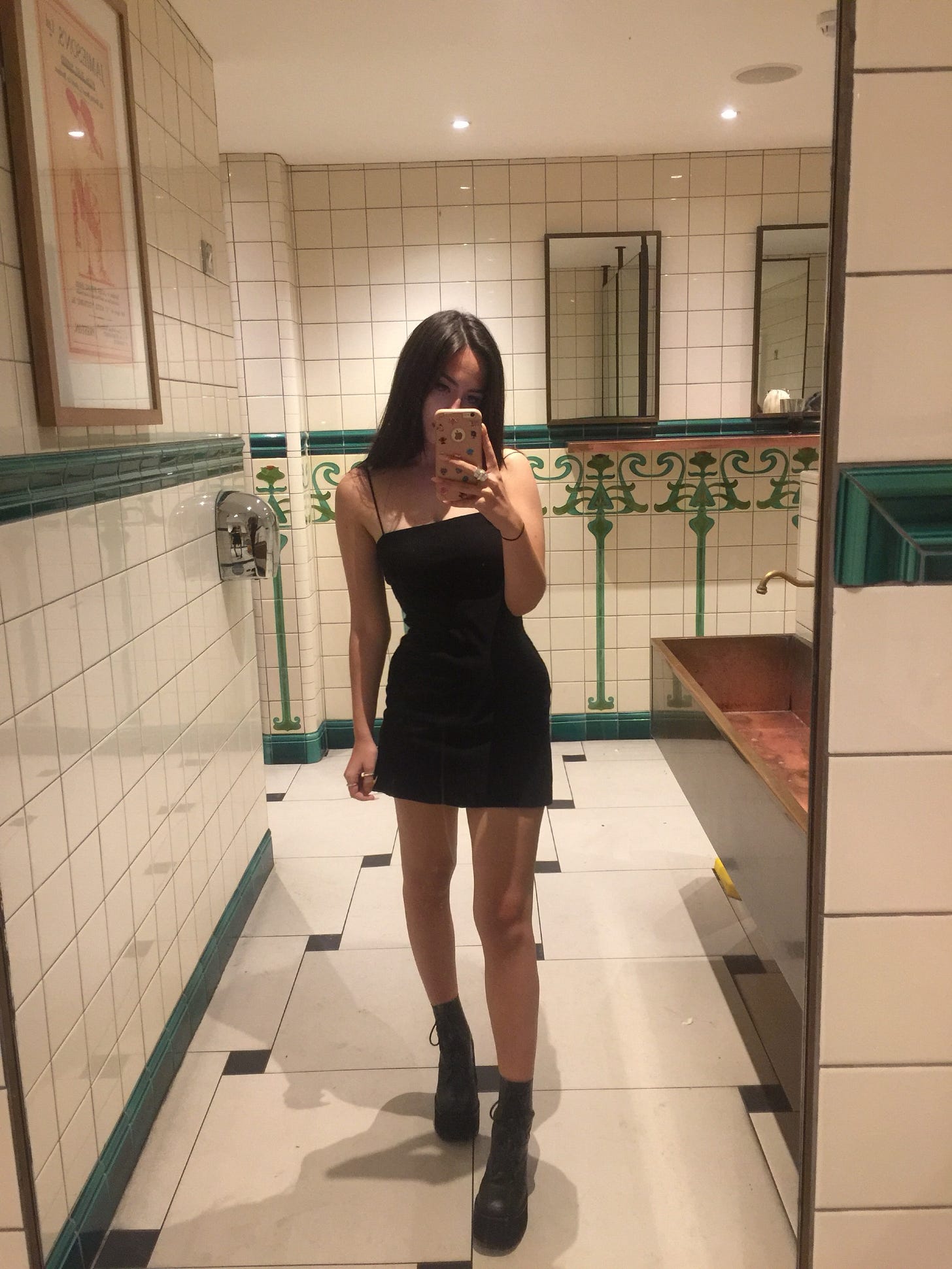
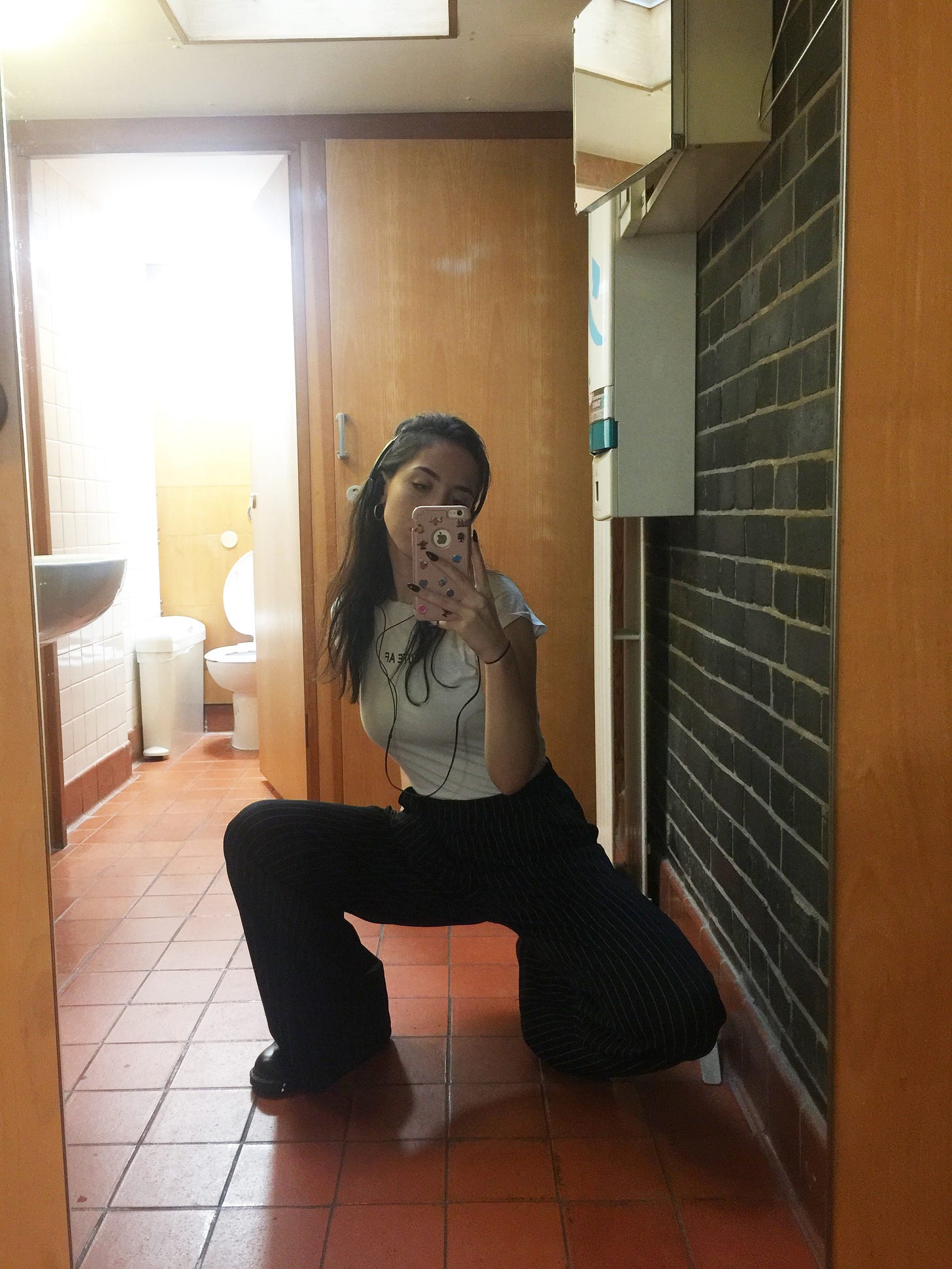

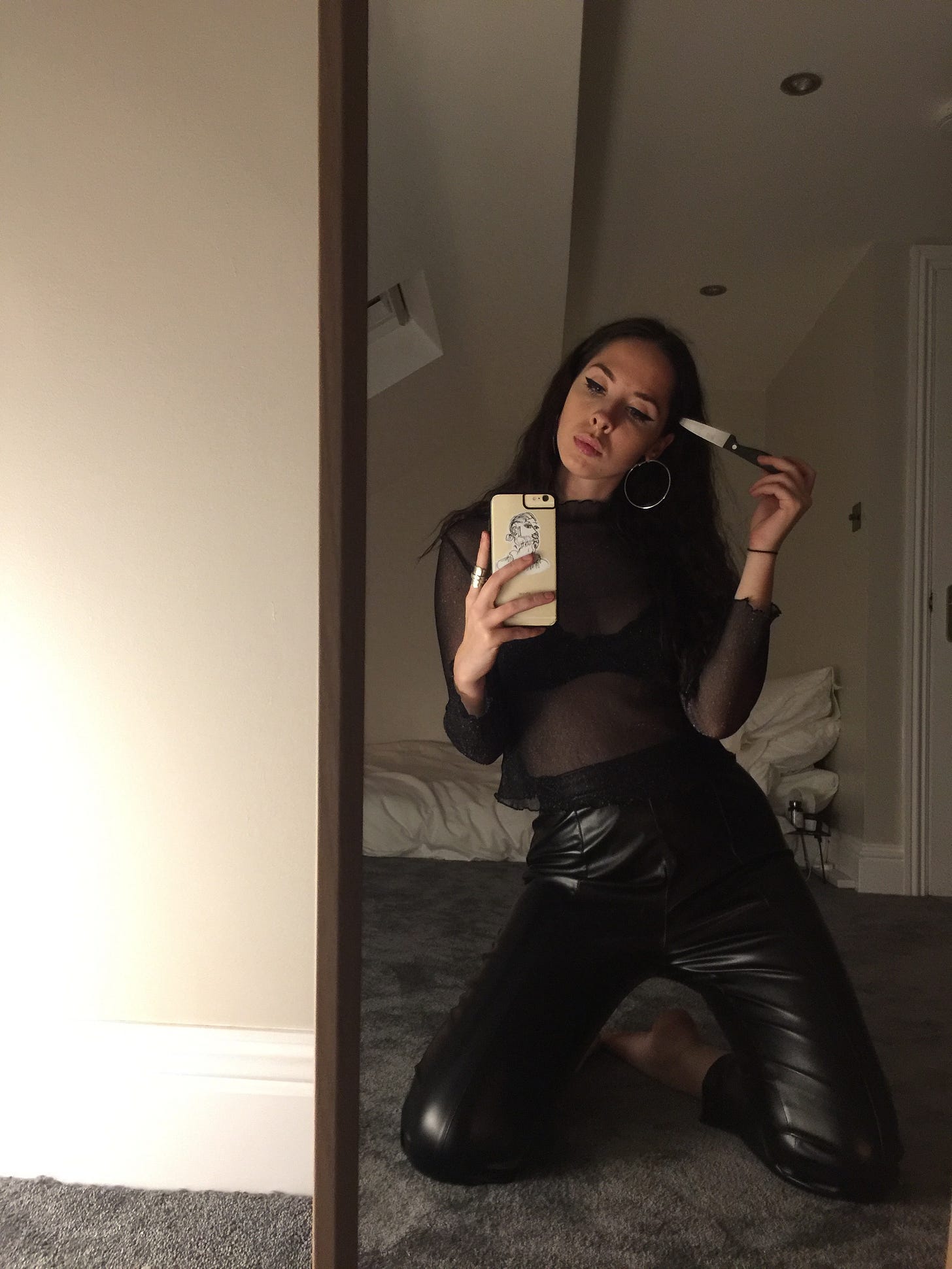
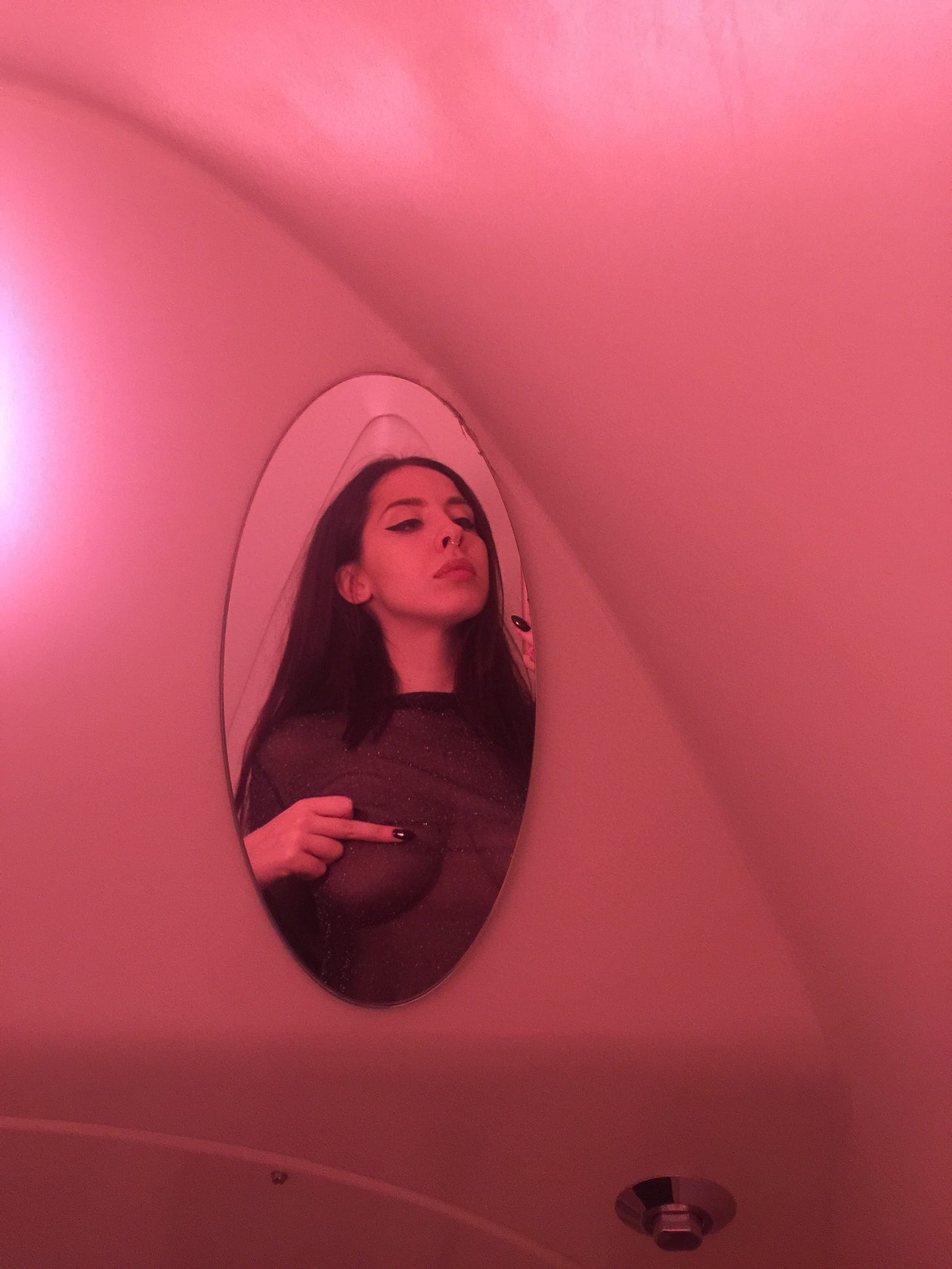
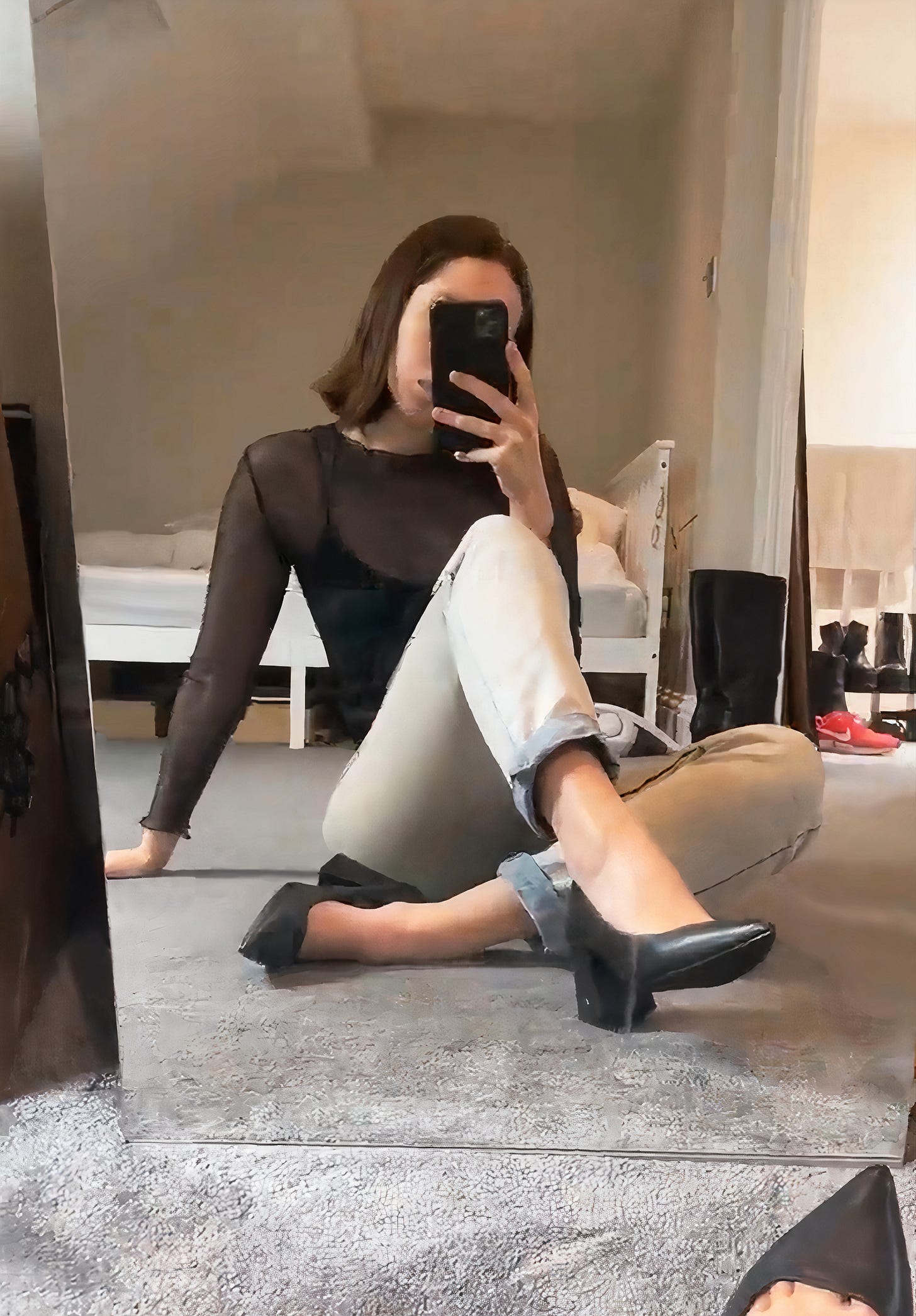

this is so good
My first thought after reading this was, "It should be some sort of interactive art piece," but then I saw that you were a performance artist and it made some sort of sense.
Good stuff. Very interesting.